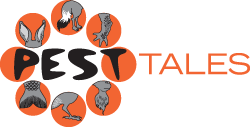Lesson Plan
Unit 2 — PEST INVADERS
Activity — Pests in the school yard
Setting the scene
Birds such as feral pigeons, starlings and sparrows are often found in cities and towns attracted by the changed surroundings humans have created. Many of these birds have the ability to adapt to disturbed environments and actively seek out opportunities to feed, nest and rear their young on or near public buildings such as schools.
Birds can be pests because they compete with native birds for food, shelter and nest sites. Birds such as sparrows and Indian mynas are particularly aggressive when defending feeding locations.
Pest birds will often inhabit a site in large numbers which can result in noise pollution, the unsightly and hazardous build up of droppings and be a source of parasites and infection such as salmonella.
Recommended reading for teachers
To gain further information on this topic prior to teaching it in the classroom is recommended that you examine sections of the following:
Aim
Students address the problem of pest birds in their school yard by manipulating the school environment.
Student outcomes
Students will:
- recognise that introduced birds can become a pest
- investigate how pest animals affect you and your school
- understand that the eradication (complete and permanent removal) of a pest is rarely achievable
- acknowledge the importance of considering animal welfare issues
- develop an understanding for the complexities involved in effective management of the damage caused by pest animals, including habitat modification
- understand and participate in effective monitoring and evaluation techniques
- conduct accurate environmental observations
- use digital technologies to record data and achieve results
- problem solve real life situations
- investigate and communicate effectively
- participate positively and effectively as individuals or in a small team
Materials
 pests in the school yard activity sheet
pests in the school yard activity sheet- bird identification books or web resources
- computer
What to do
This activity is also suitable for students working together in small groups.
Note:
Introduce the topic by discussing the ‘setting the scene’ section of the pests in the school yard activity with your students.
Ask the following questions to prompt student discussion:
What is a pest?
What is a pest bird?
Step 1
Hand out the pests in the school yard activity sheet. Discuss the requirements with your students such as how to record pest bird behaviour and how to create a database using a computer.
Step 2
Identify any problems or concerns you and your students may have with pest birds in the school yard.
Step 3
By observing the school yard, students create a list of introduced birds.
Common introduced birds found in urban areas are:
- house sparrow
- laughing turtle dove
- domestic pigeon (also known as rock dove)
- European starling
- blackbird
- Indian myna
- spotted turtle dove
Note: Students may require a reference when identifying these birds. Bird books and images sourced from the internet can assist in identification.
Students could also take photos of birds in the school yard and identify them back in the classroom.
A member of the local ornithologists group could also be approached to visit the school and assist students in identifying introduced birds in the school yard.
Step 4
Once your students have created their database and entered all of their observations, gather the class to discuss everyone’s findings.
Step 5
Record student suggestions for reducing the presence of pest birds in the school yard. Any suggestions at this stage are valid.
IMPORTANT – Suggestions can not include killing, capturing or harming the birds.
Suitable scaring techniques could include:
- shiny objects that move in the wind
- noisy objects that move in the wind
- the placement of mock predators (plastic snakes)
- large eyes that mimic predators
- scarecrows
Suitable habitat manipulation could include:
- restricting access to food and rubbish
- install lids on bins
- regular litter inspection and removal
- additional bins in high traffic areas
- nominate bin monitors who make sure bins are emptied regularly
- remove bird feeders
- changing the natural environment
- remove or add plants
- prune overhanging branches
- maintain garden beds
- remove weeds
- blocking access to roosting and nest sites on a building
- install fishing line over roosting and nest sites
- install slippery planks on roosting and nest sites
- relocating school property to areas not visited by pest birds
- making school property unattractive to pest birds
Step 6
Where possible, put into action student suggestions for reducing the presence of pest birds in the school yard.
Be aware that results will vary. This is normal as pest birds will become familiar with scaring techniques over time and ignore them. To challenge this situation, students may need to vary the type of scaring techniques employed when pest bird numbers build up. The best long-term solution is to use permanent techniques, such as installing barriers, which make an area less suitable for pest birds.
Step 7
As a suggested extension to this activity, students could design a building that deters pest birds.
Step 8







